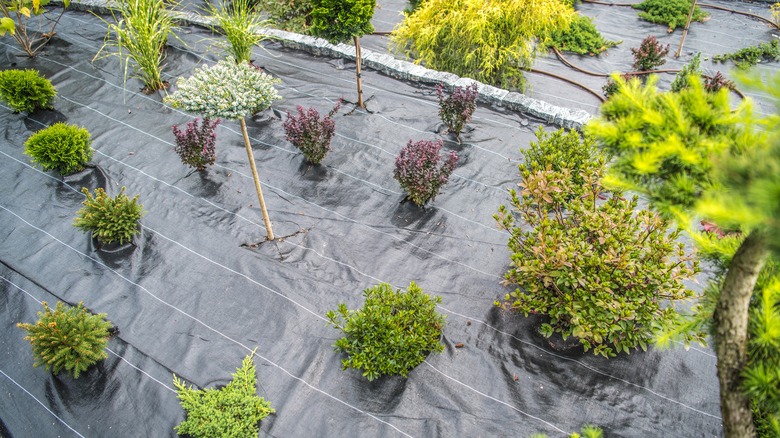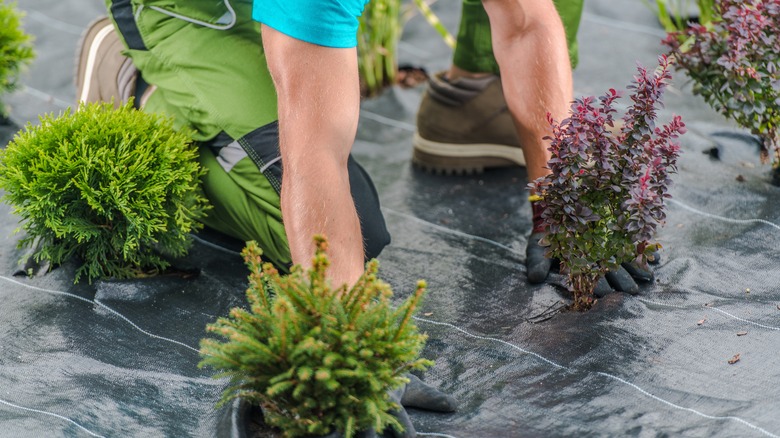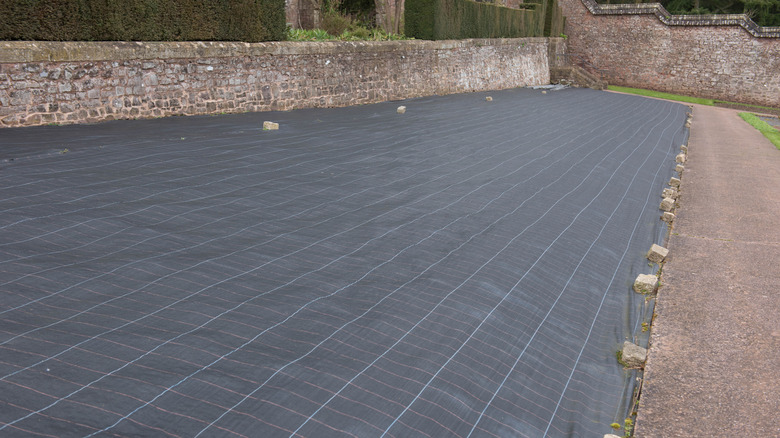The Best Type Of Landscape Fabric To Keep Weeds At Bay
Landscape fabric — also known as weed barrier fabric — is a permeable textile that blocks weeds, allowing water, air, and nutrients to reach your plants. It's not just a quick fix but a sustainable solution that prevents the growth of new weeds, minimizes soil erosion, and contributes to a healthier, more attractive garden. That being said, not all landscape fabrics are created equal. Woven landscape fabric is said to be the most common — it is highly durable, known for its exceptional weed-blocking abilities, and is typically made from woven polypropylene.
Non-woven landscape fabric, often composed of polyester or polypropylene fibers, allows for superior permeability. This is a perfect choice for your plant beds, as it lets water and nutrients seep through while still preventing weed growth. Spun-bonded landscape fabric is another option — this type involves bonding polypropylene fibers together and offers a balance between durability and permeability. It's also suitable for a variety of garden uses. Beware of landscape fabrics made from plastic. While they're often cheaper, they fail to allow moisture and nutrients to pass through to the soil, thereby inhibiting plant growth and negatively impacting soil health.
With the different types of landscape fabrics out of the way, we'll now detail the various other factors to consider to ensure you choose the right product for your needs.
Things to consider when choosing a landscape fabric
Polypropylene and polyester are the most common materials used for landscape fabrics due to their durability and ability to withstand various weather conditions. Equally important in your choice of landscape fabric are its weight and thickness, which are crucial in determining its effectiveness. Lightweight options might be easier to install but are less effective in suppressing weed growth. On the other hand, heavyweight options are more durable and better at combating weeds. A middle-ground solution would be to go for medium-weight landscape fabric. These offer the right blend of durability and flexibility and are sturdy enough to thwart weed growth — while efficiently allowing the passage of water and nutrients to the soil. They're also flexible enough for easy installation.
In your quest for the perfect landscape fabric, permeability is also a crucial feature that you shouldn't overlook. It allows water, air, and essential nutrients to reach your soil, promoting the health and growth of your plants. Without this, your soil could become dry and compacted, hindering plant development. It's also important to consider the fabric's UV resistance. The fabric should have a tight enough weave to block sunlight — UV resistance ensures the fabric won't degrade quickly under the sun, providing a long-term solution to your weed problems.
Before making a final decision, remember to assess your garden's specific needs and understand the type of weeds you are battling, your soil type, and the plants you wish to grow.
How to properly install landscape fabric
Start by preparing the area. Remove any existing weeds or vegetation from the site, leaving a clean slate for your fabric. This step is critical to ensuring that your garden bed is free of any potential weed seeds that might sprout later on. You should also level the soil, removing any stones or other debris that might tear your fabric. After preparing your garden bed, it's time to unroll the landscape fabric across the area. The fabric should cover the entire bed, extending to the edges of the planting area. If your garden bed is larger than the width of the fabric, don't worry — you can use multiple rows to overlap the edges by at least 3 inches to prevent weeds from sneaking through gaps.
If you already have plants, you'll need to cut slits in the fabric to accommodate them. Be precise as you measure the size and location of the slits needed for each plant. It's best to cut an "X" shape, allowing you to slip the fabric around the base of the plant without damaging it. Once the fabric is laid out and properly placed, place landscape fabric pins around the edges to secure it.
Lastly, it's time to cover your fabric. Mulch or stone can be used to cover it, providing an appealing aesthetic while also helping to hold the fabric in place and adding an additional layer of weed prevention. This layer should be about 2 to 3 inches thick for the best results.


